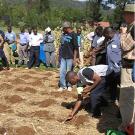Chris Enns (Canada), has been working for the past four months on a project in the community of Wagete in the Region of Mara, Tanzania. 4000 community members are suffering from and reduced crop yield due to unpredictable weather patterns related to climate change.
These challenges reduce children’s ability to receive a sound education, leading to a reduction in their ability to develop and prosper as adults. These challenges also reduce the ability of adults to lead the productive, meaningful, prosperous and hopeful lives they need to leave the cycle of poverty and contribute to the development of their communities.
| Participatory Needs Assessment |
|
 |
Chris decided to a farmer soil and water conservation program. And in August led a very comprehensive conservation agriculture workshop. You can link to a report of the workshop complete with detailed photographs of the conservation agriculture techniques they used. |
|
Chris’s simple project outline: [Problem 3] Reduced crop yield Farmer Extension Program [Solution to underlying causes: Unpredictable/late start to rainy season; mid-season drought/early end to rainy season, and increased temperatures have reduced crop harvests.]: |
|
| Conservation Agriculture: | |
 |
“Conservation agriculture aims to conserve, improve and make more efficient use of natural resources through integrated management of available soil, water and biological resources combined with external inputs. It contributes to environmental conservation as well is to enhanced and sustained agricultural production. |
Conservation agriculture incorporates three key elements:
1. Minimal tillage of the land; tilling the soil disrupts soil microorganisms and soil fauna which provide important functions and healthy soil system
2. Protecting the surface of the soil with a permanent or semi-permanent organic soil cover: mulch, leave crop residues in place—and no burning of crop residues. This organic material breaks down and provides organic material for the soil and provides a substrate for and feeds soil flora and fauna. It also increases soil moisture in reduces erosion.
3. Crop rotation; helps to avoid disease and pest problems
Conservation agriculture includes minimal tillage, mulching, and crop rotation—but it can also include softening and enriching of the soil that is specific to individual plants. For example, one technique leaves a farm field intact, but digs small planting basins 30 cm in diameter (or a rectangle 30 cm long depending on your source), 20 cm deep, and 60 cm – 75cm apart. Nutrients such as lime, compost and manure are added back into the hole, the seeds planted, and then covered by soft soil high enough to cover the seeds but low enough to leave a depression were the planting basin is. This depression collects rainwater and let’s it percolate into the soil for future use in arid regions; this might not be the best idea for areas of high rainfall. The planting basins are then mulched to protect the soil from exposure to sun (to keep soil temperatures down in hot regions), and to protect the soil from wind and rain (to reduce soil erosion and runoff— a loss of valuable rainwater).
Crops are regularly rotated to reduce depletion of valuable nutrients through hungry crops such as corn, and to prevent disease and insects taking over a permanent habitat.
You can download Chris’s full project outline here:
OL 343 Assignment 5
You can download Chris’s report of the conservation agriculture workshop — complete with great photographs here:
OL 344 Assignment Four.
Would you like to learn how to develop Community Based Adaptation Projects?
Please write us with your stories, thoughts and comments through Online.Learning@csd-i.org